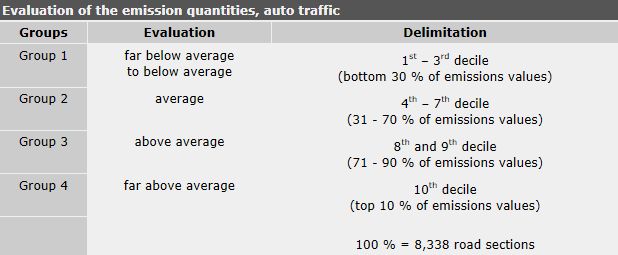Use of the model
The results of street measurements show that the concentration levels set forth in Directive 99/30/EC and the 39th BImSchV were exceeded at a large number of primary roads – continually, in the case of NO2. Since measurement-based investigations are, for cost reasons, not possible on all streets in the city, the pollution immission from all the primary roads networks in Berlin were ascertained using emission and dispersion calculations. Under this process, those streets are ascertained where the legal limit values are almost certain to be exceeded, or where they will be met.
To achieve this, these measurements are supplemented with model calculations in all traffic filled streets in which limits are potentially exceeded. However, even in a traffic filled canyon street, the background pollution produced by other sources in the city, and introduced by the long distance transportation of pollution, is an important factor. Therefore, to plan the improvement of air quality in Berlin, a system of models was developed that can calculate both the large scale influence of distant sources and the contribution of all emitters in the city, even in traffic filled canyon streets. For such an estimation of all primary roads (“screening”), the aptly designed modular programme system IMMIS▪▪▪ is suitable.
IMMIS-Luft▪▪▪ (air) is a screening programme system for the evaluation of pollution caused by road traffic. It was developed specifically for application in the context of traffic related assessments. Provided the necessary input data is known, a rapid calculation of pollution immissions is possible with the aid of this programme, both for particular streets and for comprehensive street systems.
In this process, the pollution immission is calculated on both sides of the street for one point on each side, at an elevation of 1.5 m, and at a distance of 0.5 m from the edge of the building (cf. Figure 6). The mean of the calculated immission at these two points is considered the characteristic estimate of the immission pollution in this section.
Traffic-caused air pollution immission in “canyon” streets was modelled with the programme segment IMMIScpb. It enables the calculation of hourly values of pollutant immissions produced by local traffic at any receptor in a “canyon” street with varying building heights and with spaces between buildings which allow the passage of wind, on the basis of easily accessible meteorological quantities. An additional required input quantum is the emission level for each section of the street. The emissions were calculated from the current traffic data using the programme segment IMMISem. The pollution produced by the city is derived from the sum of the additional pollution measured using the “canyon street” model, the local street traffic, and the urban background pollution calculated using the IMMISnet programme.
Evaluation based on an index
The map drafted using this process shows the spatial distribution of traffic caused air pollution for NO2 and PM10. A comprehensive assessment was conducted for both substances. The index developed weighs the calculated concentrations of both pollutants according to their limit values throughout the network of road sections of the primary roads network for 2009, which has been expanded to some 10,000 for this purpose, and adds the quotients. For example, if the two components both reach 50% of the limit, an index of 1.00 will result. All sections that show a reading in excess of 1.8 (90% or more of the limit value) will require special attention in future (cf. Effects on Human Health).
Data display for Map 03.11.2 Traffic-caused air pollution
The data display in the FIS Broker includes the following detailed information on selected road sections:
- Section Number
- Name of the road section
- Length of road section [m]
- Average daily traffic volume (DTV) 2009
- Number of heavy trucks ( > 3.5 t) per day in 2009
- Number of light trucks ( < 3.5 t) per day in 2009
- Number of public transport buses per day in 2009
- Number of motorcycles per day 2009
- Location in the Environmental Zone (1 = yes)
- Affected residents on the road section
- Emission data for 2009 based on the following substances:
- Nitrogen oxides emissions in [g/(m/day)]
- PM10 emissions in [g/(m/day)]
- PM2.5 emissions in [g/(m/day)]
- The calculated emissions for 2009 based on the following substances:
- NO2 (annual average in mg/cu.m) 2009
- PM10 (annual average in mg/cu.m) 2009
- PM2.5 pollution (annual average in mg/cu.m) 2009
- The trend calculations of emissions for 2015 and 2020, respectively based on the following substances:
- NO2 (annual average in mg/cu.m) 2015
- PM10 (annual average in mg/cu.m) 2015
- PM2.5 pollution (annual average in mg/cu.m) 2015
- NO2 (annual average in mg/cu.m) 2020
- PM2.5 pollution (annual average in mg/cu.m) 2020
- The calculation of the air pollution index based on the pollutants NOx and PM10:
- Air pollution index for NO2
- Air pollution index for PM10
- Overall air pollution index for NO2 and PM10.

